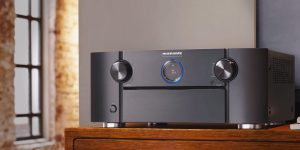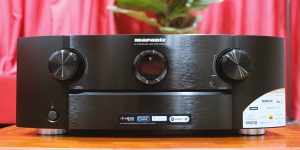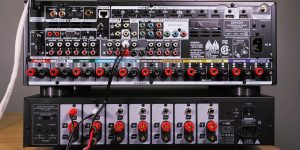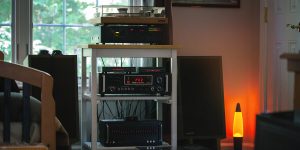When faced with choosing an AVR, many of you may think that a budget option means a compromise on quality or features. However, in my experience, this is not always the case. While you can’t say no compromises are waiting for you at all, in fact, some of the fairly versatile models on the market are reasonably priced. I offer you my list from which you can choose the best budget AV receiver. We’ll look closer at the contenders that work for your home entertainment system. These models offer a great balance between performance, functionality, and cost, making them ideal for those who want to enjoy home theater without emptying their pockets.
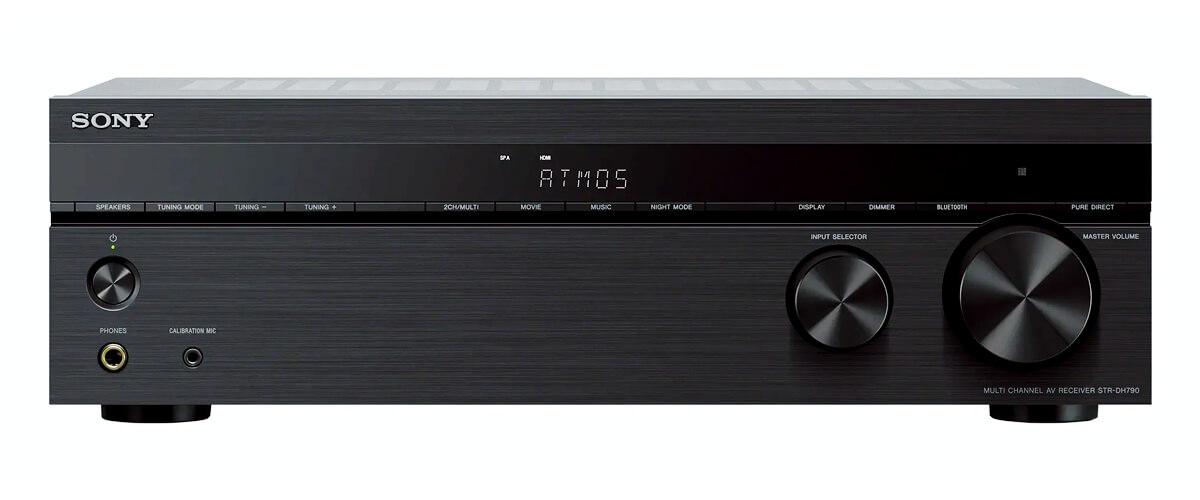
Budget AV receivers comparison table
| Name | Channels | Power output | HDMI in/out | Bluetooth/Wi-Fi | Review |
|---|---|---|---|---|---|
| Sony STR-DH790 best overall | 7.2 | 145W/6 Ohms | 4/1 | yes/no | Review |
| Denon AVR-S570BT also great | 5.2 | 70W/8 Ohms, 90W/6 Ohms | 4/1 | yes/no | Review |
| Yamaha RX-V385 | 5.1 | 70W/8 Ohms | 4/1 | yes/no | Review |
| Pioneer VSX-534 | 5.2 | 80W/8 Ohms | 4/1 | yes/no | Review |
| Onkyo TX-SR393 | 5.2 | 80W/8 Ohms | 4/1 | yes/no | Review |
The main features that you should pay attention to in a budget AV receivers
Buying the right affordable AV receiver can seem daunting because your choice depends on various factors. I will tell you which ones I look at first, and they will help you understand your needs, making your future search easier.
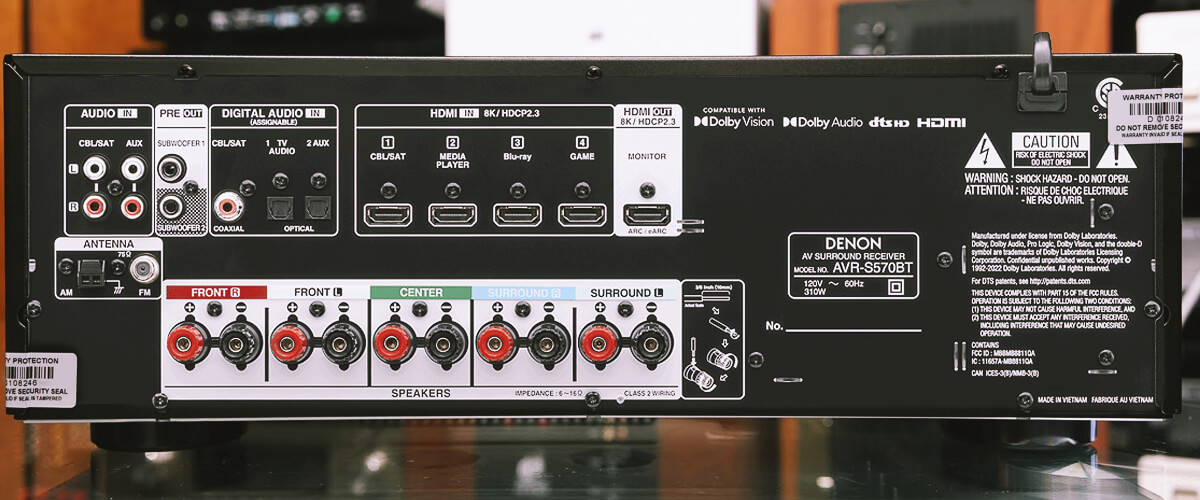
Receivers amplification channels
So, you’re building your home theater and wondering how many channels of gain you need in your receiver, right? It all depends on your speaker configuration. Most budget receivers will cover your needs if you start with a simple 5.1-channel system. But if you have ambitions aimed at a more advanced 13.1 channel system, you may need to dig a little deeper. In my experience, most budget receivers have 5-channel amplification, which is pretty standard. However, the Sony STR-DH790 receiver stands out in our review, offering 7-channel amplification, which sets it apart from the competition.
Power rating
Let’s talk about power. Do you have a small room – 160-320 ft²? Then you’re in luck! Сheapest AV receiver usually delivers about 50-80W per channel, which should suit you. But if you plan to move to a larger room or upgrade your system later, a budget receiver may not be right for you. Although power is not the only deciding factor, it should be considered when matching the power capabilities of the receiver with your speakers.
Connectivity options
When evaluating budget AV receivers, please pay close attention to their connectivity options. Most important to me are HDMI inputs and outputs with ARC, eARC, HDCP, and phono. Keep in mind that budget receivers usually offer 4-5 HDMI inputs. Is that enough for you? Also, don’t forget outdated but still functional connections like digital audio input and component video input if you have a lot of older equipment. Built-in Bluetooth, Wi-Fi, and streaming services are also a big plus. Oh, and not all of them have Wi-Fi, so double-check before you buy!
Video compatibility
A little secret: most cheap AV receivers do not have a scaling function. So be sure to pay attention to 4K/120 Hz support. 4K/60Hz resolution support is desirable if you are considering an older model. Dreaming of 8K/60Hz? The Denon AVR-S570BT might be your optimal choice, as 8K support is a rarity in this price range. Also, check compatibility with the most common formats for today’s content, HDR10, Dolby Vision, and HLG.
Surround sound formats
Since home theater is about surround sound, you need a budget AV receiver that supports modern formats like Dolby Atmos, DTS:X, or Auro-3D. But not all low-cost options support these formats, but some of the products we reviewed, such as the Sony STR-DH790, Onkyo TX-SR393, and Pioneer VSX-534, offer Dolby Atmos and DTS:X support. Of course, if you buy a receiver that only supports older formats, it’s not the end of the world, but you have to agree that having more modern equipment is an advantage.
Best budget receiver reviews
Sony STR-DH790 – best overall

The first receiver on my list, let me introduce you to the 2018 Sony STR-DH790. It’s the most expensive AVR in this review, but you’ll justify every penny you invest with it. Don’t believe it? Let’s take a look.
First, it’s the only budget option in our chart that offers 7.2 channels of amplification (which means you can connect two subwoofers, too). With it, you can build a system in a 5.2.2 configuration for maximum surround sound enjoyment with overhead speakers connected. It’s a staggering 145W output (6 Ohm, 1kHz, THD 0.9%, 1 ch), but I wouldn’t go all the way up; you won’t get good sound quality. But you can connect any speakers from 6 to 16 ohms to it.
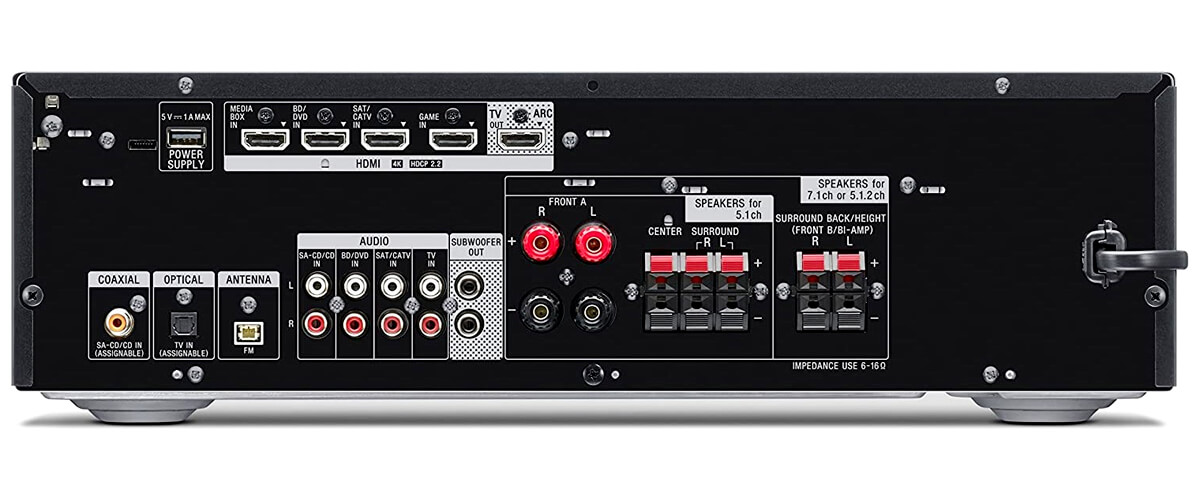
The STR-DH790 has 4 HDMI ports (HDCP 2.2), which is normal for its category. With them, you can watch videos in HDR10, HLG, and Dolby Vision with 4K/60Hz resolution, and the only HDMI output has eARC support. Moreover, a budget-range model rarely boasts support for Dolby Atmos and DTS:X. Another plus I consider is the channel organization allowing bi-amping for the two front speakers.
In addition to the lack of Wi-Fi, there is no wired Ethernet. And this is a somewhat surprising disadvantage for me. Of the wireless connectivity at your disposal, unfortunately, only Bluetooth. And whether this is, a worthy compromise is up to you to decide. But to be fair, it is worth noting that it supports the AAC codec, which allows you to listen to Apple equipment without losing quality.

The controls are simple and easy, but the calibration system is not the latest technology in this receiver. With its help, I could adjust only the size of the speakers, levels, distances, and EQ, and the rest had to be done manually, although it was easy enough. The video to try out the system I chose is dynamic and filled with different soundtracks, from peaceful dialogues to intense music. It was the movie Arrival, and it left a great impression after watching it. Since the STR-DH790 has no phono input, I connected via Bluetooth. Deezer worked smoothly, and I enjoyed my selection without feeling any blatant shortcomings in the broadcast.
We can conclude that the Sony STR-DH790 is a great mid-range option for those looking for a budget AV receiver with impressive features and performance. Despite some shortcomings, which I attribute to accepting compromises, it offers much more features than its competitors. It, therefore, gets first place in my rating and the title of the best budget receiver.
Specifications of Sony STR-DH790
- Channels: 7.2.
- Output power: 145W/6 Ohms.
- HDMI inputs/outputs: 4/1.
- Surround sound
- Dolby features: DSD, Dolby Digital, Dolby Atmos, Dolby Dual Mono.
- DTS features: DTS HD Master, DTS:X, DTS-ES.
- Video
- Video functions: 4K/60Hz pass-through.
- Video support: HDMI ARC, HDMI eARC, HDMI CEC, HDCP2.2, HLG, HDR10, Dolby Vision.
- Bluetooth/Wi-Fi: yes/no.
- Streaming service: has not.
Pros
- 7.2 channels of amplification – a great option for this price rank.
- Bi-amping for the two front speakers.
- Availability of Dolby Atmos and DTS:X surround sound formats.
- Bluetooth with AAC codec.
- Easy setup.
Cons
- No Wi-Fi and wired Ethernet.
- No phono input.
Denon AVR-S570BT – also great
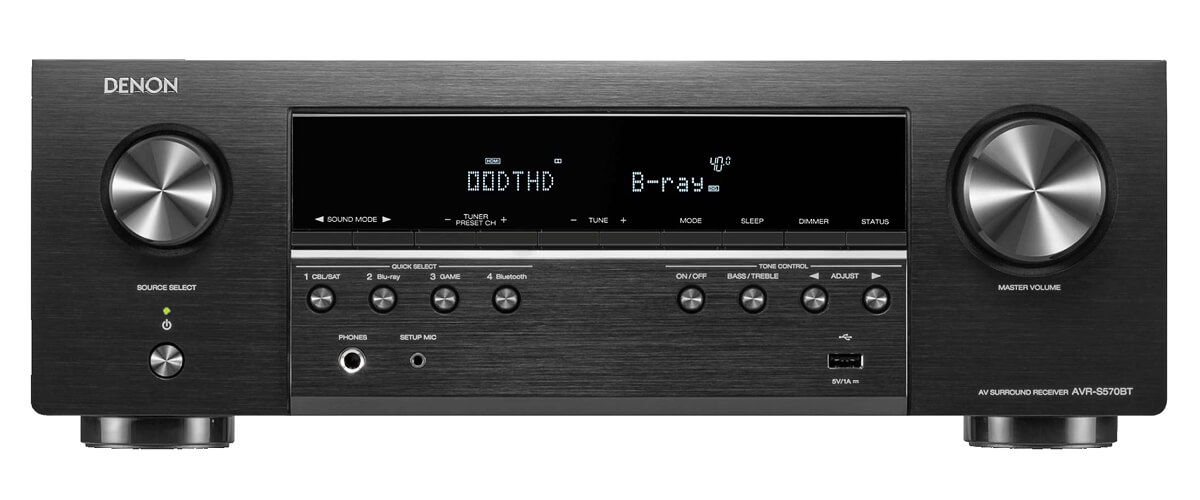
On the second place of honor is the Denon AVR-S570BT. From its name, it is clear that it, like Sony STR-DH790, has Bluetooth (but, by the way, also no Wi-Fi or Ethernet connectivity). The Denon was released in 2022 and is a modern device, so let me tell you more about it.
With this 5.2 channel receiver, you can use two subwoofers and get 70W (8 Ohm, 20Hz – 20kHz, 0.08%, 2ch) or 140W (6 Ohm, 1 kHz, 10%, 1ch) power. Yes, these receivers are designed for small spaces, so don’t get them if your room is larger than 320ft².
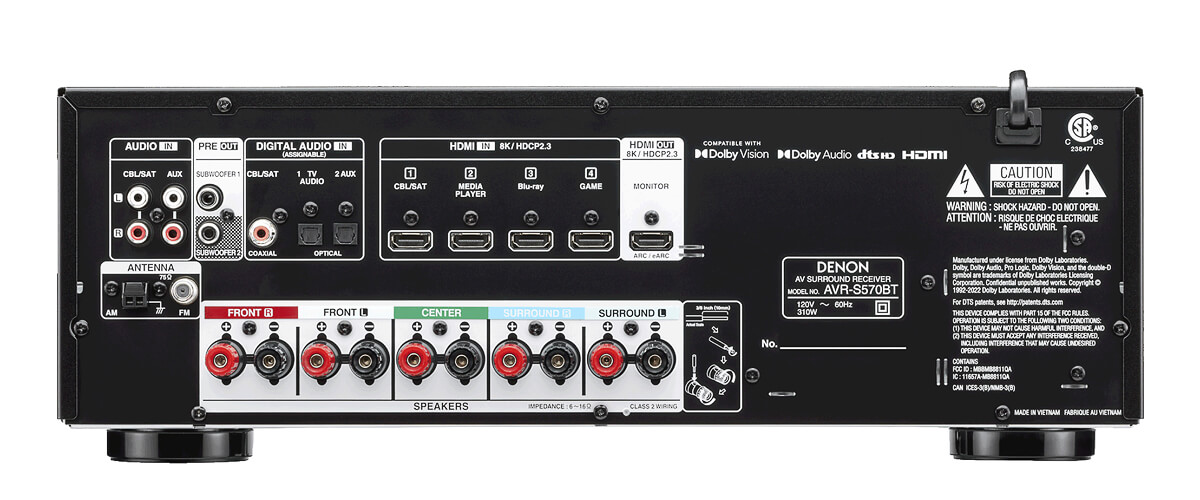
The Denon AVR-S570BT also has 4 HDMI input ports (HDCP2.3) and one HDMI output port (ARC, eARC) like its predecessor on my list so that it will give you quality video and audio, including 8K/60Hz and 4K/120Hz AB resolution for HLG, Dolby Vision, HDR10+ formats. I also like its 3D Signal and 8K Signal Pass-through options. So in these metrics, Denon pulls ahead. But in surround sound – it gives up its position, providing the opportunity to listen only to Dolby TrueHD and DTS-HD Master Audio. Although for a 5-channel receiver, this is quite understandable (and yet some exceptions imitate Dolby Atmos surround sound).
You will not find anything else besides the standard USB port in this receiver. The setting is done with a simple and clear interface and calibration mic. But agree, the above basic and most important aspects of the AVR-S570BT are just fine!
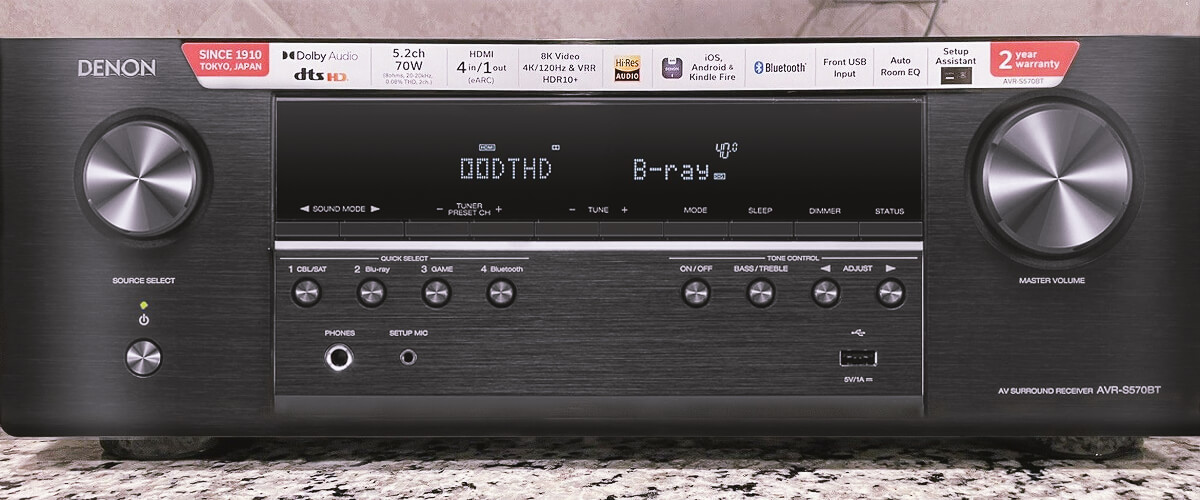
So, I decided to try it out, for which I started watching the movie Mission: Impossible – Fallout. I had to turn the sound down a bit because it lags at high volume, but overall I didn’t notice any glaring flaws. Considering the receiver’s price, it did a good job conveying the picture’s complex sound line. The Bluetooth streamed Spotify with ease, and the warm sound of the Denon filled my apartment.
It is a relatively new model on the market today, and you won’t find many reviews of the Denon AVR-S570BT, but I trust the brand’s quality. Even a short acquaintance with it left a pleasant impression, and I am happy to enlist it in the ranks of the best budget home theater receiver.
Specifications of Denon AVR-S570BT
- Channels: 5.2.
- Output power: 70W/8 Ohms, 90W/6 Ohms.
- HDMI inputs/outputs: 4/1.
- Surround sound
- Dolby features: Dolby TrueHD.
- DTS features: DTS HD Master.
- Video
- Video functions: 4K/120Hz, 8K/60Hz pass-through, upscaling to 8K.
- Video support: HDMI ARC, HDMI eARC, HDMI CEC, HDCP2.3, HLG, HDR10, HDR10+, Dolby Vision.
- Bluetooth/Wi-Fi: yes/no.
- Streaming service: has not.
Pros
- Supports 8K/60Hz video resolution.
- Signal pass-through for 3D signal and 8K.
- The wireless was good.
- Simple interface.
Cons
- No Wi-Fi or wired Ethernet.
Yamaha RX-V385
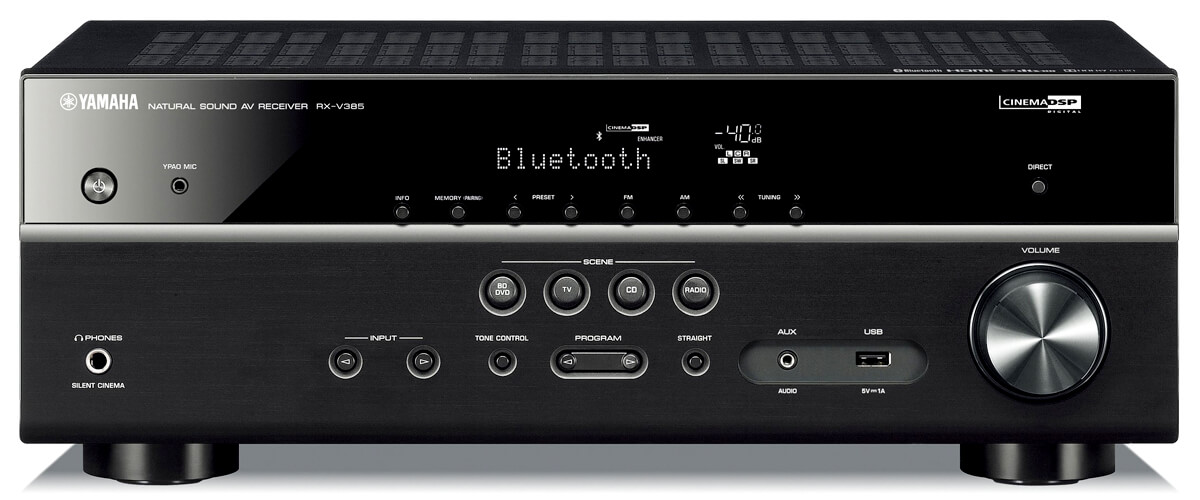
Well, I’ve got a diverse bunch here, so meet the Yamaha RX-V385, born in 2018. It is the only receiver on the chart that has no second subwoofer option, so fans of bass, when you need it and don’t need it, you can move on. This AVR is for users with normal requests and is the budget 5.1 receiver. I was pleased with its capabilities, especially considering its low cost.
Since I always start with connectivity, I won’t change my habits and will tell you about HDMI ports, which are as many here as in Denon AVR-S570BT (4/1). But compared to AVR-S570BT, they only give you 4K/60Hz video resolution (4:4:4 Upscaling) and have 3D Pass-through capabilities. The video formats are also a bit easier, and they are HDR10 (instead of HDR10+), Dolby Vision, and Hybrid Log-Gamma, but they are quite comparable.

The RX-V385 also doesn’t offer Dolby Atmos, but exclusive CINEMA DSP technology supports audio formats like Dolby TrueHD, Dolby Digital Plus, and DTS-HD Master Audio. It’s enough for the content presented today. But the system’s feature is that you can put all 5 speakers in the front and still be in the middle of the action thanks to the virtualization of surround sound. That’s pretty cool, I think. Yes-yes, there’s no Wi-Fi here, but Bluetooth will keep you busy.

Although the Yamaha RX-V385 is not very powerful, offering only 70W (8 Ohm, 20Hz-20kHz, 0.09%, 2ch), I was nevertheless pleased with the sound quality. First of all, I like the slightly cooler shade of the brand; it makes dialogue and music clearer, giving the impression of clarity and transparency. So I listened to Metallica and watched the movie Rock Star with it to experience the true sound of classic distortion. And (ha!) the receiver has YPAO auto-calibration, which has proven to be a simple and easy way to tune the system.
When it comes to the budget AVR, you should not get upset about the simplicity and limited capabilities of the device because, looking at the Yamaha RX-V385, it is impossible not to appreciate those important basic options which make up for all the shortcomings.
Specifications of Yamaha RX-V385
- Channels: 5.1.
- Output power: 70W/8 Ohms.
- HDMI inputs/outputs: 4/1.
- Surround sound
- Dolby features: Dolby TrueHD, Dolby Digital Plus.
- DTS features: DTS HD Master.
- Video
- Video functions: 4K/60Hz pass-through.
- Video support: HDMI ARC, HDMI eARC, HDMI CEC, HDCP2.3, HLG, HDR10, Dolby Vision.
- Bluetooth/Wi-Fi: yes/no.
- Streaming service: has not.
Pros
- Quality video transmission with 4K/60p resolution (4:4:4 Upscaling).
- Virtualization of surround sound with the placement of all speakers at the front.
- High THD even at low power.
- YPAO auto-calibration technology.
Cons
- No Wi-Fi.
Pioneer VSX-534
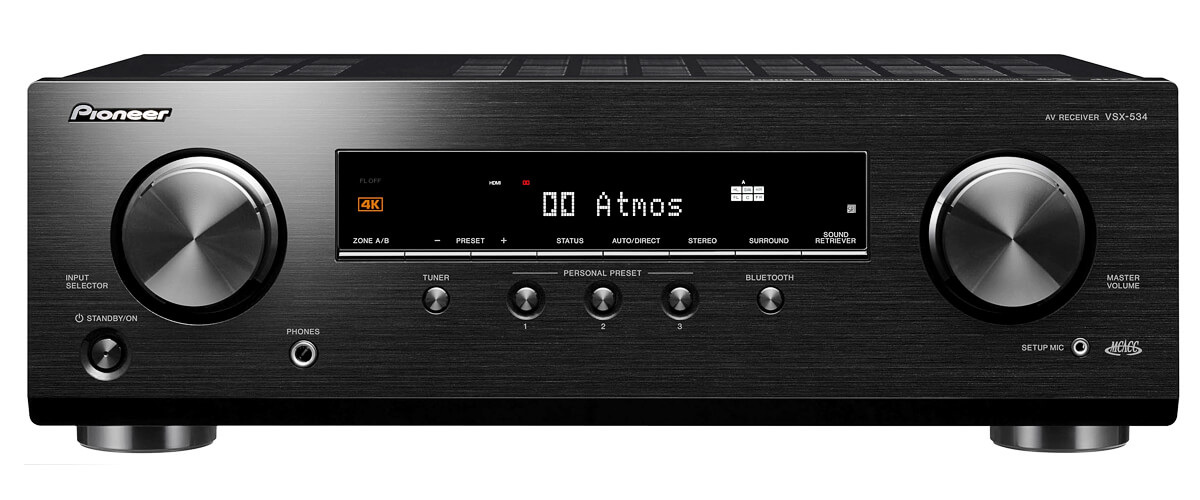
Another budget receiver on my list is the Pioneer VSX-534, released in 2019. The 5.2-channel AVR, despite its incredibly low price, offers us great features, and the brand’s reputation does not let us doubt the device’s reliability.
This model even has slightly more power than the previous Yamaha RX-V385 at 80W (8 Ohm, 20Hz-20kHz, 08%, 2ch).
With a category-standard connection set including 4 HDMI inputs (HDCP 2.2 compatible) and 1 output (ARC), the receiver offers you HDR10, HLG, and Dolby Vision video viewing at 4K/60Hz resolution (with 4:4:4:4 color space support). It doesn’t stand out from the crowd even with the 4K Ultra HD Pass-Through feature.
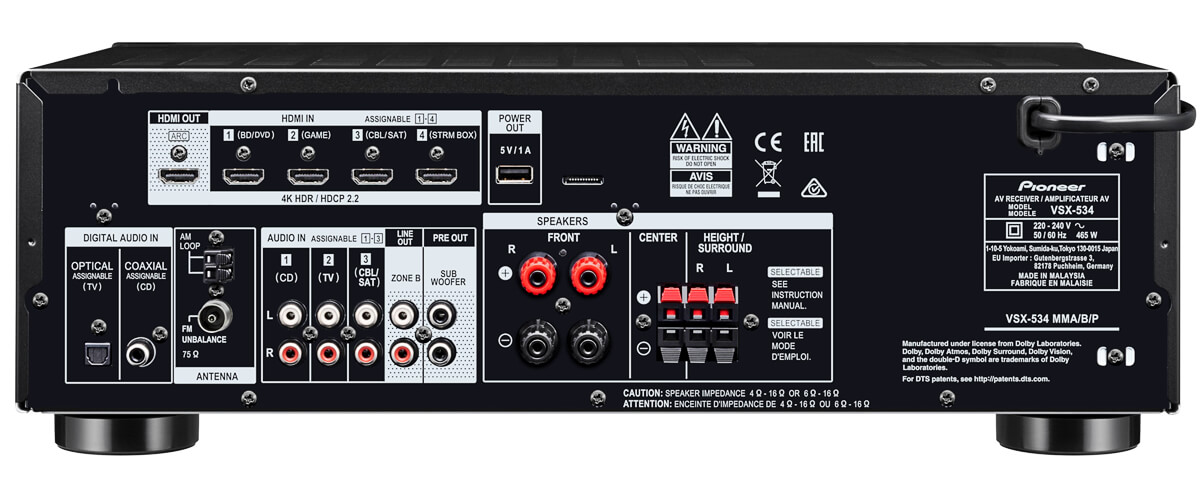
The sound, however, is a bit of a different story. You may have noticed that you can connect a second sub to the VSX-534, but you’d call me crazy if I called that a bonus. No, we’re talking Dolby Atmos and DTS:X surround sound, which is pretty uncommon in 5-channel receivers. But even if you don’t have dedicated speakers, with Dolby Atmos Height Virtualization, following the manufacturer’s wording, you still get the effect of surround sound “based on a traditional speaker layout without additional speakers.” Of course, this is not a unique option in general, but I draw your attention to it exactly from the perspective of affordable equipment.
In terms of sound, the brand also added MCACC auto-calibration. Still, you can also save your settings with the Personal Preset button (with three presets), adjust the dialog volume against the background of the overall soundtrack, and listen to music in another area of the apartment or home with wireless headphones. The Pioneer VSX-534 has Bluetooth built-In for this purpose, but like the rest of our chart participants, it has no Wi-Fi and Ethernet.
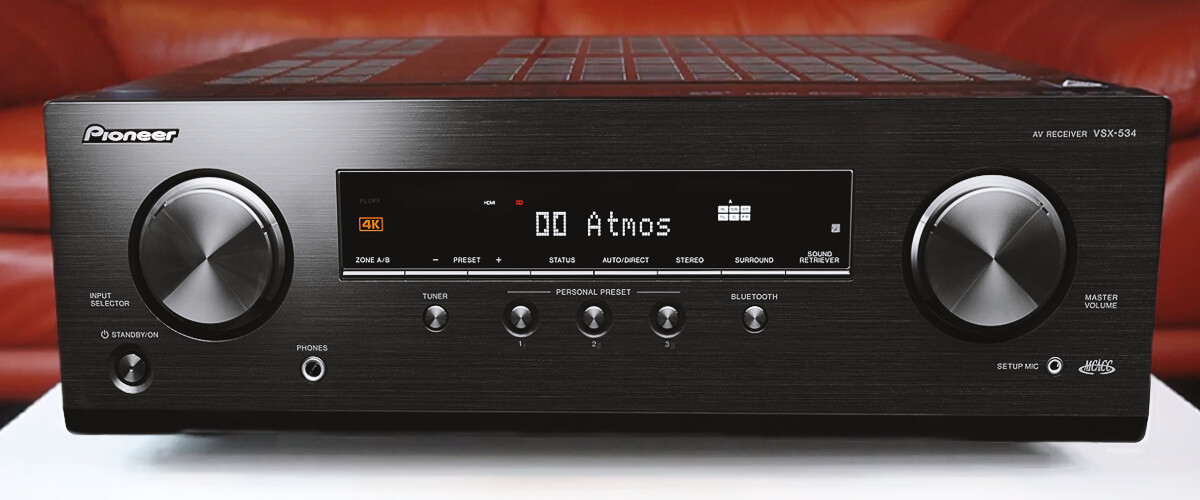
My testing experience with the receiver was trying to surround sound virtualization and listening to music on headphones. While watching the movie Fight Club, in the scene where Edward Norton and Brad Pitt are driving in the car in the rain, I played around with the dialogue adjustments, and it was a very fun experience. And the sounds of shattering glass, when the characters hit another car were like scattering around and over me, so I was pleased with the simulated three-dimensional sound. Listening to music also left me pleasantly impressed. My favorite track by Fleetwood Mac, The Chain, sounded smooth and deep, with Stevie Nicks’ clear vocals.
The budget Dolby Atmos receiver Pioneer VSX-534 will be a good choice for those looking for a budget receiver with versatile features and easy operation. Its build quality, and advanced surround sound features will last a long time.
Specifications of Pioneer VSX-534
- Channels: 5.2.
- Output power: 80W/8 Ohms.
- HDMI inputs/outputs: 4/1.
- Surround sound
- Dolby features: Dolby TrueHD, Dolby Digital Plus, Dolby Atmos, Dolby Atmos Height Virtualizer.
- DTS features: DTS HD Master, DTS:X, DTS Neural:X, DTS Virtual:X.
- Video
- Video functions: 4K/60Hz pass-through.
- Video support: HDMI ARC, HDMI eARC, HDMI CEC, HDCP2.2, HLG, HDR10, Dolby Vision.
- Bluetooth/Wi-Fi: yes/no.
- Streaming service: has not.
Pros
- Slightly more power than competitors.
- Supports Dolby Atmos and DTS:X surround sound formats.
- Even without additional speakers, Dolby Atmos Height Virtualization provides upper channel simulation.
- Use the Personal Preset button to save your settings.
- You can adjust the volume of the dialogs.
- You can listen to the sound in another area with wireless headphones.
Cons
- Considering the cost of the receiver, there is simply no point in scolding it. However, its shortcomings are obvious and similar to those described in other models.
Onkyo TX-SR393

The Onkyo TX-SR393 came out in 2019, just like the Pioneer VSX-534. And it offers almost identical options, so I’ll try not to repeat myself too much. For example, the receiver has the same 5.2-channel configuration and 80W per channel power (8 Ohm, 20Hz – 20kHz, 0.08%, 2 ch). However, this is quite normal data for our price category.
The TX-SR393’s connections and video are also exactly comparable to the VSX-534’s specifications. You can view content in 4K/60Hz (4:4:4) quality and HDR10, HLG, and Dolby Vision formats. But this model can improve the resolution from 1080p to 4K and 4K pass-through. Unfortunately, 8K is unavailable on this receiver, and it clearly wasn’t enough for me. The number of HDMI ports (4/1) and their configuration (HDCP 2.3, 3D, ARC, and CEC) are no different from the other models. For me, as a music lover, the presence of the phono input is important, but here, as in other models, it is not. However, you can connect to the receivers with an analog input with an external preamplifier.
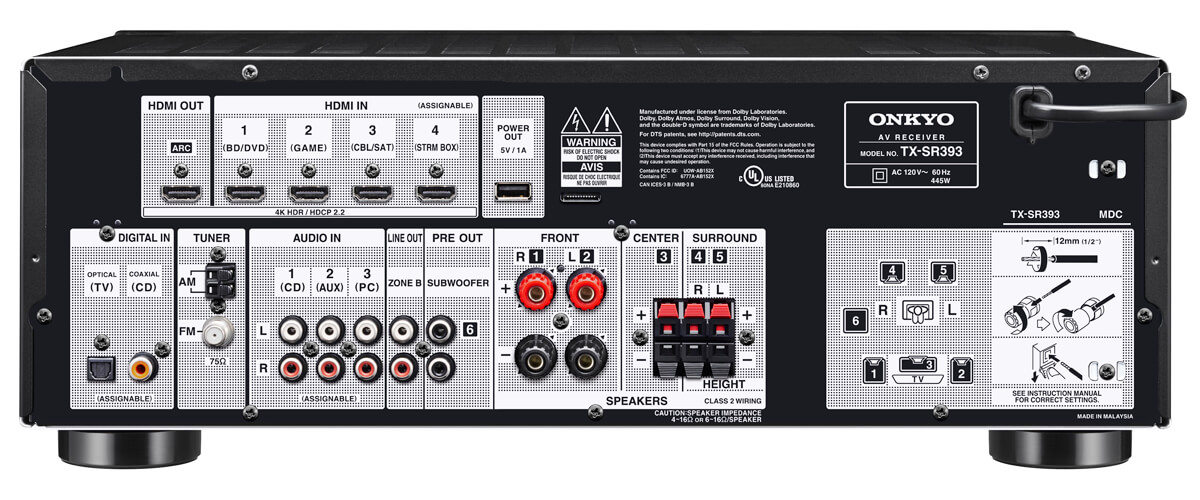
Did you think that at least this model had Wi-Fi? Unfortunately, no. But all the manufacturers have solved this problem by having Bluetooth, and in this case, you will not be left without it.
It will no longer surprise you that the Onkyo TX-SR393 is compatible with Dolby Surround and DTS Neural:X surround sound formats. With these, you can access the “over-the-top” sound experience as they find the top signals in older soundtracks. And also, Dolby Atmos Height Virtualizer, like the Pioneer VSX-534, contributes to an exceptional experience (though not in full, of course) of simulated playback of the upper channels.

The very simple and convenient AccuEQ auto-calibration technology helped me prepare to watch the movie. This time I chose Prometheus and the intense music combined with the sound produced by the spaceships left me completely satisfied. The TX-SR393 did an excellent job of conveying the complex production and subtle electronic elements of the track “Bad Guy.” The heavy bass beat was powerful but not overwhelming. I loved it.
I’m sure the Onkyo TX-SR393 will find many fans as it is one of the best budget AVRs, offering us simplicity, functionality, and imitation of the upper channels of sound.
Specifications of Onkyo TX-SR393
- Channels: 5.2.
- Output power: 80W/8 Ohms.
- HDMI inputs/outputs: 4/1.
- Surround sound
- Dolby features: Dolby TrueHD, Dolby Atmos Height Virtualizer, Dolby Atmos, Dolby Surround upmixing.
- DTS features: DTS HD Master, DTS:X, DTS Neural:X upmixing, DTS Virtual:X.
- Video
- Video functions: 4K/60Hz pass-through.
- Video support: HDMI ARC, HDMI CEC, HDCP2.3, HLG, HDR10, Dolby Vision.
- Bluetooth/Wi-Fi: yes/no.
- Streaming service: has not.
Pros
- The option to enhance the resolution from 1080p to 4K and 4K pass-through.
- Easy setup and auto-calibration.
- Simulation of the upper channels of surround sound.
Cons
- Does not provide 8K resolution movie playback capability.
- No phono input.




![Best 2-Channel Receiver [Expert Reviews and Buying Guide]](https://hometheaterology.com/wp-content/uploads/2023/11/best-2-channel-receiver-stereo-300x150.jpg)


